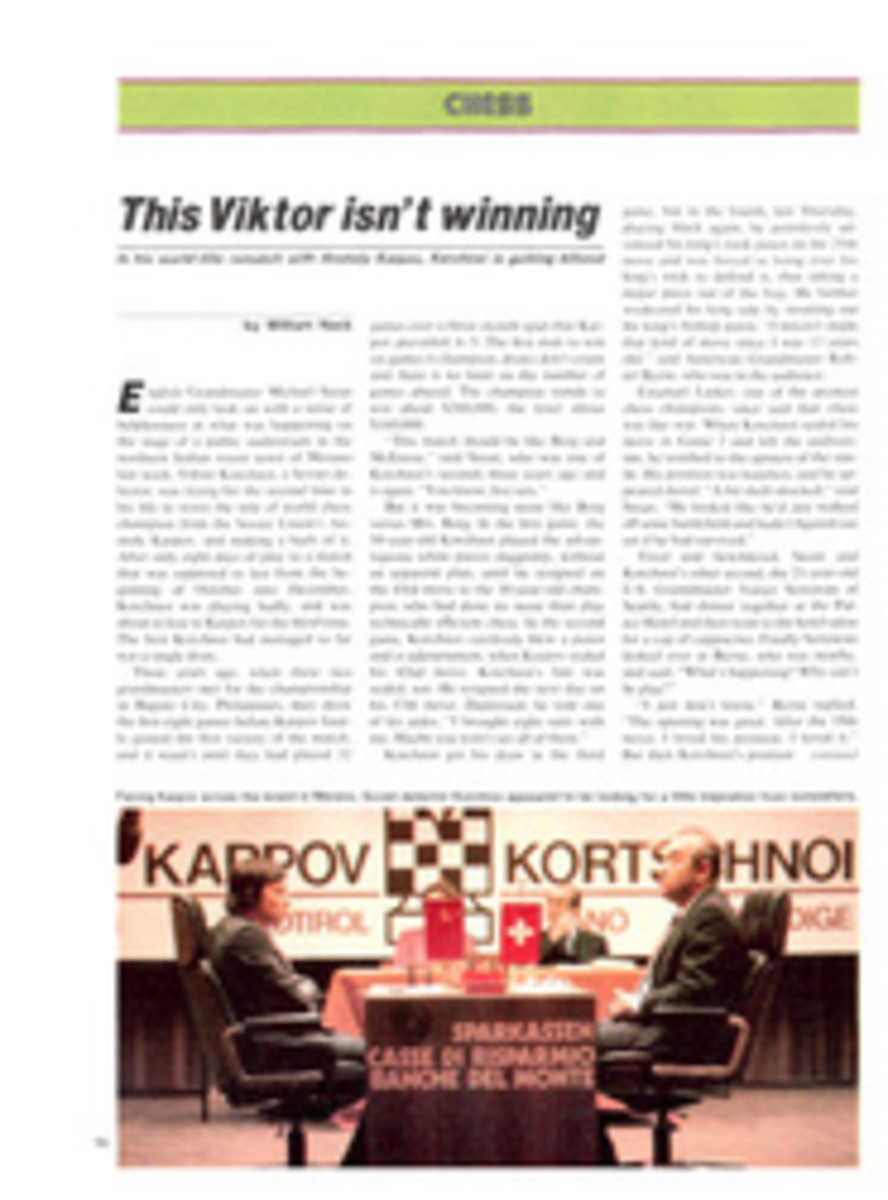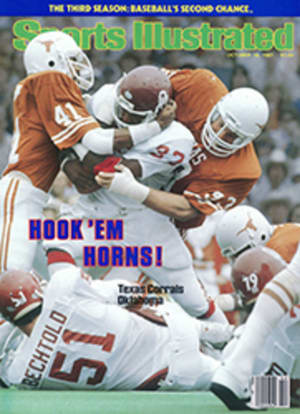
The Iron Men of Phillips Used Just 12 Players in Upsetting Mighty Texas
It rattles like a dried gourd and looks more like a misshapen pumpkin than a football. But the faded score that had been meticulously lettered on its side is still legible: TEXAS U. 0—PHILLIPS U. 10.
Almost every fall, the football is transferred from the Phillips University archives to a display case on the school's Enid, Okla. campus as a proud reminder of an intercollegiate football program that died in 1933. The ball is the only trophy of the 1919 Phillips team, known as Mauley's Iron Men, that was considered by many experts to be the finest football squad in the Southwest that year.
Coached by John Maulbetsch, who had been an All-America halfback at Michigan, the Iron Men briefly lifted Phillips, a private liberal arts university founded in 1906 as Oklahoma Christian University and later renamed after oilman Thomas W. Phillips, from athletic obscurity with an undefeated season and laid claim to the Oklahoma and Southwest championships.
Maulbetsch was attracted to Phillips in 1917 as coach and director of athletics when a group of Enid businessmen, headed by an enthusiastic Michigan alumnus, promised to underwrite half the expenses of an expanded athletic program. Although World War I played havoc with schedules and rosters, Maulbetsch built a formidable football program during his first two years, despite being called into the Naval Aviation Corps after the second game of 1918. The remainder of that season he sent instructions to the team by mail, guiding them by remote control to a 4-1 record.
Maulbetsch returned to Phillips in 1919 and began preseason workouts with a squad of more than 30 players that included nine lettermen, several high school stars and a number of former servicemen. By the opening game, the squad had been whittled to fewer than 20. Three starters later achieved national prominence in various aspects of sport.
Doug Roby, former president of the U.S. Olympic Committee and currently one of two Americans on the 88-member International Olympic Committee, was captain of the Iron Men and a halfback noted for his broken-field running. After 1919 he transferred to Michigan and, having sat out a year, played the '21 and '22 seasons with the Wolverines under Coach Fielding H. (Hurry Up) Yost.
The other two notable Iron Men were Steve Owen and Ev Shelton. After Phillips, Owen played pro football, first with the Kansas City Cowboys (1924-25) and then the New York Giants (1926-31). He coached the Giants from 1931 to 1952, winning eight divisional and two NFL titles (1934 and 1938). In 1966 he was posthumously inducted into the Pro Football Hall of Fame.
Shelton was similarly honored in 1979 by the Naismith Basketball Hall of Fame. As a college hoops coach, Shelton had 494 career wins in 32 years at Phillips, Wyoming and Sacramento State. His 1943 Wyoming team won the NCAA title.
But in 1919 Shelton was one of numerous students returning to Phillips from military service in Europe, where he had played halfback in the American Expeditionary Force football finals in Paris after the armistice. By that time Maulbetsch had already spotted the powerfully built Owen on campus and introduced him to the game, which he had never played before, by personally engaging him in a 30-minute blocking and tackling drill. "Mauley was a pretty rough customer," says Dutch Richards, the youngest member of the Iron Men and, at 80, one of the few still living. "He was rough in language, rough in actions, rough in his choice of friends."
He was also a strict disciplinarian. Maulbetsch required that players carry rule books at all times and gave rule and signal quizzes four days a week. Misconduct such as cigarette smoking or arriving late at practice was punished with extra running, which occurred often enough for the local newspaper to remark that several players might do well in track.
Perhaps the player who epitomized the Iron Men was Dutch Strauss, a 200-pound fullback who subsequently played pro football with Kansas City. Strauss was an excellent passer, a powerful runner and a punishing linebacker. Against Oklahoma in 1917, he scored a touchdown and drop-kicked a 55-yard field goal despite two broken ribs.
Given the kind of talent that was on hand for the 1919 season, Maulbetsch's biggest headache was arranging a competitive schedule. Only half Phillips' playing dates were filled by mid-September, and Maulbetsch found it difficult to schedule many of the logical Oklahoma and Kansas opponents because of his previous successes against them. It originally had appeared that the Iron Men would open the season against Texas on Oct. 11, but he was able to arrange games with two nearby Oklahoma schools before the trip to Austin.
The first outing resulted in a 90-0 rout of Kingfisher College, in which Strauss scored five touchdowns and Phillips' defense allowed only one first down—on a penalty. Less impressive was Phillips' sluggish 27-0 win over Northwestern Normal the next week. Though sloppily played and full of fumbles, the game allowed Maulbetsch to solidify his starting lineup, with one costly exception—Roby was sidelined with a shoulder separation that would put him out of the Texas game.
Earlier that day, Phillips passed an enrollment milestone with the matriculation of its 1,001st student that year, a Cheyenne-Arapahoe Indian named John Levi. The 6'2", 205-pound Levi, an outstanding athlete, had lettered in football and basketball at Phillips the year before, and his late enrollment in 1919 was fortuitous, to say the least. He reported to practice five days before the Texas game and was immediately installed in the starting backfield, in Roby's place.
Although it later became apparent that Texas, then as now a Southwest football powerhouse, had underestimated Phillips, the outcome of the game was no fluke. In his book, My Kind of Football, Owen recalled the unorthodox strategy Phillips used that day. According to Owen, the Iron Men jumped to a 10-point lead and had visions of rolling up the score. But Texas was using 35 men to Phillips' 12—Maulbetsch dared not use what little bench he had—and he feared an aggressive offense would wear out his team. He told the Iron Men to forget about attacking, to punt on first downs and to concentrate on defense.
"John Levi could kick a ball a mile," wrote Owen, "and we played in Texas territory all the game." Owen was a storyteller, not a historian, and his report probably captures the spirit of the game better than its details.
Phillips did use only 12 men and Levi had a fine day punting, but newspaper reports focused on Strauss's performance. "Big 200-pound Strauss of the Phillips squad was the sensation of the game," wrote the Austin American, "taking part in all the major plays of the game, bucking Texas' lighter line at will and wielding a powerful toe that often proved marvelous." Strauss scored the game's only touchdown in the second quarter on a pass from Quarterback Harry Schwimmer and drop-kicked a 25-yard field goal with 40 seconds remaining in the half.
The upset stunned Texas and led to stories that Phillips had used ringers, but Texas Athletic Director Theo Bellmont quickly squelched the rumors and later said. "Undoubtedly Phillips has the best team on the gridiron in this section."
By the end of the season, few would dispute Bellmont's statement. In 10 games Phillips rolled up 424 points and allowed opponents 14. The only blemish on its record came on Nov. 15 at Stillwater when Oklahoma A&M recovered a blocked punt in Phillips' end zone to gain a 7-7 tie. Oddly enough, one week thereafter the Aggies tied the state's other football power that year, Henry Kendall College (later the University of Tulsa), by the same score.
Kendall had beaten Oklahoma 27-0—the Sooners didn't play Phillips that season—and was also undefeated. Comparative scores with common opponents indicated that the Iron Men and Kendall were well matched, so after Kendall failed to beat Oklahoma A&M, Maulbetsch suggested a postseason playoff game that would determine the state and Southwest champion.
Kendall Coach Francis Schmidt came to Enid on Thanksgiving Day to watch Phillips beat Denver University 58-0 on an icy field. During the visit, Schmidt told Maulbetsch he would let him know his decision about the postseason game on Tuesday. When Maulbetsch didn't hear from Schmidt, he wired his last challenge, offering Kendall two possible playing dates and the home-field advantage.
Two days later, Schmidt responded: "Sorry not to have wired sooner. We do not expect to play Phillips. We do not consider that a win over two normal schools and a tie with the Aggies gives much of a state championship. America is a free country. Claim the title." The Iron Men did.
As a result of Phillips' startling success, it was admitted to the Southwest Conference for the 1920 season. But with the loss of several key Iron Men, Phillips had a disappointing 4-5-1 record and failed to score in conference play. It immediately dropped out of the conference. Maulbetsch was hired to coach Oklahoma A&M in 1921 and, unable to keep up with the highly competitive and growing programs in the region, Phillips' football reputation gradually faded. The Iron Men, however, had left behind a taste of glory and a very special football.
ILLUSTRATION

